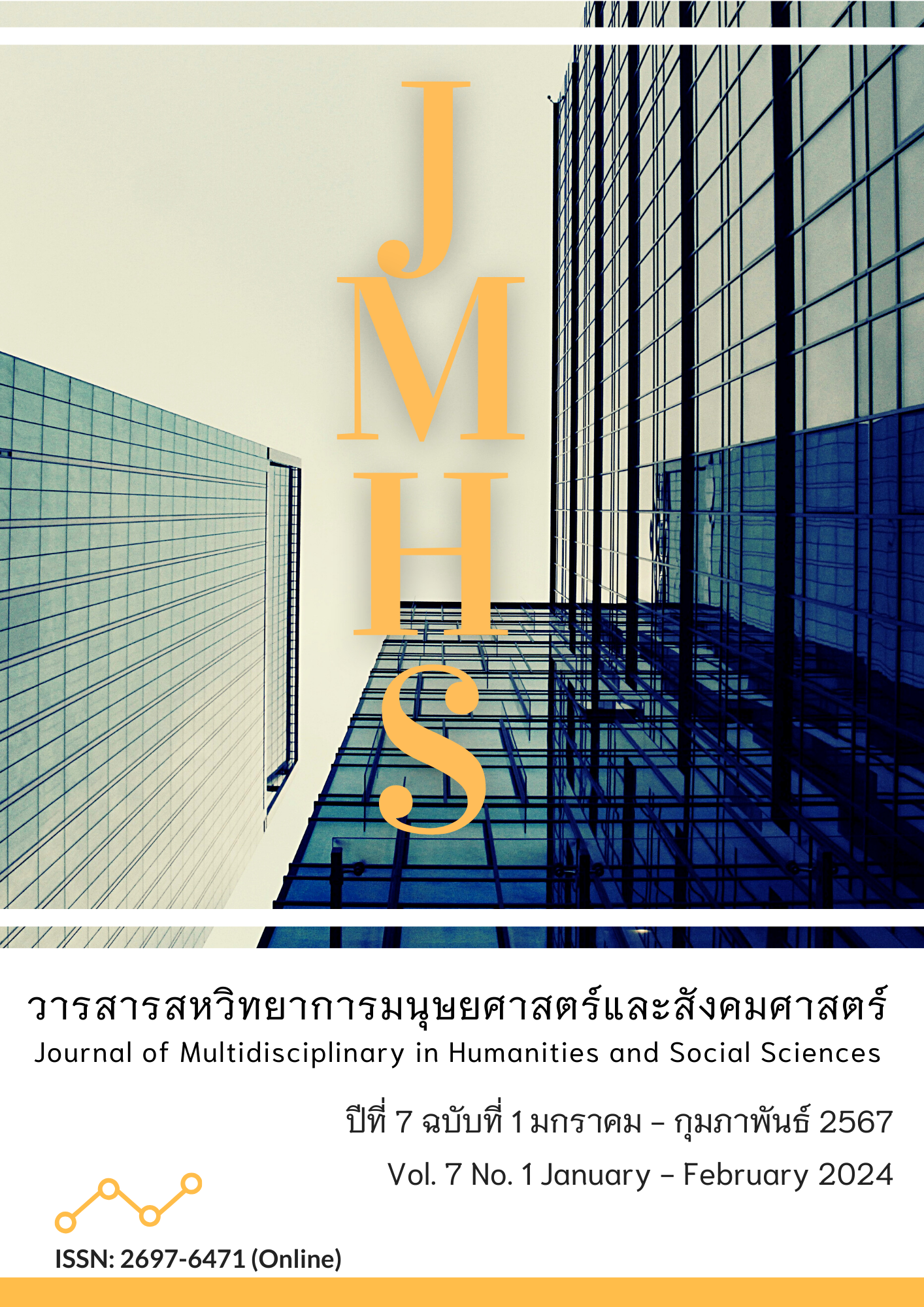The Development of Multidimensional Metacognition Scale for Middle School Students: An Application of Within–Items Multidimensional Item Response Theory
Main Article Content
Abstract
This Article aimed to (1) construct and develop multidimensional metacognition scale for middle school students and (2) verify the quality of multidimensional metacognition scale for middle school students. The sample was 1,072 middle school students under the Chiang Mai Secondary Educational Service Area Office. They were selected by multi-stage sampling. The instrument for collecting data was multidimensional metacognition scale for middle school students. Analysis data by confirm factor analysis (CFA) and Multidimensional Graded – Response Model. The research results were found as follows;
1. The Multidimensional Metacognition Scale for early secondary school students, consists of 22 items. It is characterized as a situational assessment with 5 scenarios, presented in a multiple-choice format with 4 options each. The content validity (IOC) of multidimensional metacognition scale for 22 items are 0.80 - 1.00, item Discriminant index (rxy) range from 0.233 – 0.535 and reliability is 0.825.
2. The quality of multidimensional metacognition scale, the first check the agreement on multidimension was fitted well with the empirical data (c2 = 148.721, df = 123, p-value = 0.057). The slope parameter of Metacognitive Knowledge (MK) dimension is between 0.949 - 2.235, The slope parameter of Metacognitive Experience (ME) dimension is between 0.110 - 3.095. The difficult parameter (Threshold: βi) is the lowest order value (β1 < β2 < β3). Reliability by EAP, MK dimension is 0.859 and ME dimension is 0.862.
Article Details

This work is licensed under a Creative Commons Attribution-NonCommercial-NoDerivatives 4.0 International License.
Views and opinions appearing in the Journal it is the responsibility of the author of the article, and does not constitute the view and responsibility of the editorial team.
References
กลุ่มสารสนเทศ สำนักนโยบายและแผนการศึกษาขั้นพื้นฐาน. (2566). สถิติข้อมูลทางการศึกษา ปีการศึกษา 2566. สืบค้นเมื่อ 20 มิถุนายน 2566 จาก http://www.bopp.go.th/?page_id=1828.
ชัยวิชิต เชียรชนะ. (2552). การวิเคราะห์พหุมิติ (Multidimensional Analysis). วารสารศึกษาศาสตร์ มหาวิทยาลัยขอนแก่น, 32(4), 13-22. สืบค้นจาก https://so02.tci-thaijo.org/index.php/EDKKUJ/article/view/49858
ทิศนา แขมมณี และคณะ. (2544). วิทยาการด้านการคิด. กรุงเทพฯ: เดอะมาสเตอร์กรุ๊ปแมนเนจเมนท์.
ปาริชาติ ทาโน, ศิริชัย กาญจนวาสี และ โชติกา ภาษีผล. (2561). การตรวจสอบความตรงเชิงโครงสร้างของแบบวัดอภิปัญญาของนักศึกษาพยาบาลด้วยการวิเคราะห์องค์ประกอบเชิงยืนยัน. วารสารเกื้อการุณย์, 25(2), 7-20. สืบค้นจาก https://he01.tci-thaijo.org/index.php/kcn/article/view/160995
พรพิมล ระวันประโคน และสมบัติ ท้ายเรือคำ. (2562). การพัฒนาแบบทดสอบออัตนัยพหุมิติ. Journal of Community Development Research (Humanities and Social Sciences), 10(4), 13-23. สืบค้นจาก https://www.journal.nu.ac.th/JCDR/article/download/1615/1198/
พิมพันธ์ เดชะคุปต์. (2544). “เมตาคอกนิชัน (Metacognition)”. วิทยาการด้านการคิด. ใน ทิศนา แขมมณี, (บรรณาธิการ). กรุงเทพฯ: เดอะมาสเตอร์กรุ๊ปแมนเนจเมนท์.
ศศิธร เยื่อใย, ธิติยา บงกชเพชร และ ปราณี นางงาม. (2563). การพัฒนาอภิปัญญาและผลสัมฤทธิ์ทางการเรียนวิทยาศาสตร์โดยการจัดการเรียนรู้แบบใช้ปัญหาเป็นฐาน เรื่อง การเจริญเติบโตและการตอบสนองของพืช สำหรับนักเรียนชั้นมัธยมศึกษาปีที่ 5. วารสารบัณฑิตวิทยาลัย พิชญทรรศน์, 15(2), 149-158. สืบค้นจาก https://so02.tci-thaijo.org/index.php/Pitchayatat/article/view/244332
ศิริชัย กาญจนวาสี. (2556). ทฤษฎีการทดสอบแบบดั้งเดิม. (พิมพ์ครั้งที่ 7). กรุงเทพฯ: จุฬาลงกรณ์มหาวิทยาลัย.
ศิริชัย กาญจนวาสี. (2563). ทฤษฎีการทดสอบแนวใหม่. (พิมพ์ครั้งที่ 5). กรุงเทพฯ: จุฬาลงกรณ์มหาวิทยาลัย.
สมศักดิ์ ภู่วิภาดาวรรธน์. (2544). การยึดผู้เรียนเป็นศูนย์กลางและการประเมินตามสภาพจริง. เชียงใหม่: The Knowledge Center.
Anderson, L. W., & Krathwohl, D. R. (2001). A Taxonomy for Learning, Teaching and Assessing: A Revision of Bloom’s Taxonomy of Educational Objectives. New York: Longman.
Baker, L., & Brown, A. L. (1980). Metacognitive Skill and Reading. Illinois: Center for the Study of Reading.
Beyer, B. K. (1987). Practical Strategies for the Teaching of Thinking. Boston: Allyn and Bacon.
Costa, A. L. (1984). Mediating the Metacognitive. Educational Leadership, 11, 57-62. Retrieved from https://files.ascd.org/staticfiles/ascd/pdf/journals/ed_lead/el_198411_costa.pdf
Cross, D. R., & Paris, S.G. (1988). Developmental and Instructional Analyses of Children’s Metacognition and Reading Comprehension. Journal of Educational Psychology, 80(2), 131-142. https://doi.org/10.1037/0022-0663.80.2.131
Flavell, J. H. (1979). Metacognition and Cognitive Monitoring: A New Area of Cognitive Development Inquiry. American Psychologist, 34(10), 906-911. https://doi.org/10.1037/0003-066X.34. 10.906
Flavell, J.H. (1985). Cognitive Development. New Jersey: Prentice-Hall.
Jiang, S., Wang, C., & Weiss, D. J. (2016). Sample Size Requirements for Estimation of Item Parameters in the Multidimensional Graded Response Model. Frontiers in Psychology, 7(109), 1-10. https://doi.org/10.3389/fpsyg.2016.00109
O’Neil, H. F., & Abedi, J. (1996). Reliability and Validity of a State Metacognitive Inventory: Potential for Alternative Assessment. The Journal of Educational Research, 89(4), 234-244. https://doi.org/10.1080/00220671.1996.9941208
Pintrich, P. R., & de Groot, E. V. (1990). Motivational and Self-regulated Learning Components of Classroom Academic Performance. Journal of Educational Psychology, 82(1), 33-40. https://doi.org/10.1037/0022-0663.82.1.33
Reckase, M. D. (2009). Multidimensional Item Response Theory. New York: Springer.
Schraw, G., & Dennison, R. S. (1994). Assessing Metacognitive Awareness. Contemporary Educational Psychology, 19, 460-475. https://doi.org/10.1006/ceps.1994.1033
Wilson, M., & Hoskens, M. (2005). Multidimensional Item Responses: Multimethod-Multitrait Perspectives. In: Maclean, R., et al. Applied Rasch Measurement: A Book of Exemplars. Education in the Asia-Pacific Region: Issues. Concerns and Prospects. Vol 4. Springer, Dordrecht. https://doi.org/10.1007/1-4020-3076-2_16


